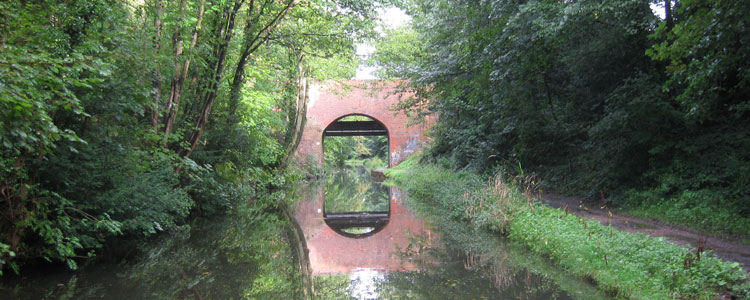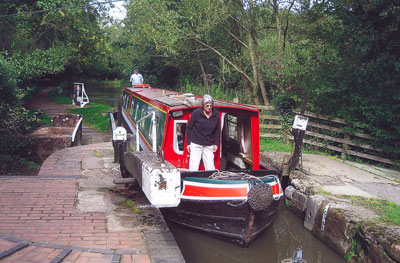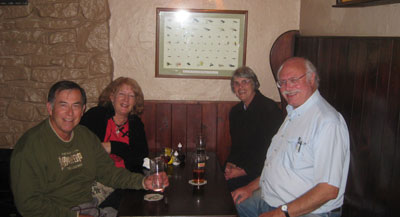Narrowboating through the English countryside – an enjoyable but sometimes challenging endeavor
by Carl Chavez, Graeagle, CA
My wife, Margaret, and I have made many trips to Great Britain, often to visit her cousin near Oxford and our friends in Scotland. On our September ’10 visit, we were looking for a different experience.
For many years we have had a timeshare with Diamond Resorts International (Las Vegas, NV; 877/374-2582), which we’ve utilized throughout the US and Europe. I noted that, besides traditional hotels and condos, they list canal boats operating from several marinas in England in their inventory of stays.
Through Diamond Resorts, I was able to book a boat for a week, boarding at Alvechurch, south of Birmingham. Nonmembers can book directly with Alvechurch Marina (phone +0121 445 1133). The cost for the size of boat we booked would be approximately $2,300 plus fuel.
Getting there
In order to break up the long flight from Reno, Nevada, to Britain, we first flew to New York, utilizing our Southwest Rapid Rewards points. As members of the Affordable Travel Club (Gig Harbor, WA: phone/fax 253/858-2172), we stayed two nights with a club member on Long Island ($20 per night, breakfast included). We were conveniently located near a railroad station and only 10 miles from JKF Airport.
The next day we flew on to London as part of a Go-Today.com package (Bothell, WA; 800/227-3235) that included the round-trip flight from New York to Heathrow and three nights at the Queens Park Hotel, opposite Hyde Park ($1,872 for two).
Our Scottish friend Roisin, who lives near Glasgow, met us the next day for the requisite sightseeing of London. She also would join us for the upcoming canal boat trip.
Two days later we all checked out of our hotel and boarded a public bus for the hour-long ride to Oxford, where Cousin Bill met us and took us to Long Cottage, his thatch-roofed abode in Eynsham, a few miles northwest of Oxford. The real adventure was about to begin.
Learning the ropes
We left Bill’s home on Sunday, Sept. 5, and drove two hours north to Alvechurch, where our boat, the Kenilworth Castle, awaited us. Our canal boat was a long, narrow, craft (7½' x 70') outfitted to accommodate six people. Fully furnished with a complete kitchen and dining area with a convertible bed, it had two separate bedrooms — one with a double bed and the other with twin beds — and two toilets with showers.
To say that we were inexperienced sailors would be an understatement, as we knew virtually nothing about boat operations. Fortunately, the helpful staff at the marina was fully prepared for folks like us. First we were required to watch a video on safety and boat and lock operations. This was followed by a one-on-one training session with a model of a lock that allowed hands-on training of the procedure needed to go both “uphill” and “downhill” on our travels.
Finally, after loading our craft with our belongings and the food we had purchased on the drive up from Eynsham, we were given onboard instruction on the boat operations and the minor maintenance duties necessary to keep us afloat.
Our instructor then moved our boat out of the confined dock area jammed with 25 boats similar to ours, and we were on our own.
Fortunately, during the planning stages of our canal trip, Bill had purchased a copy of “Collins Nicholson Waterways Guide 2: Severn, Avon & Birmingham,” the canal boat “bible” that’s a must for anyone traveling the British canal system. The book contains detailed maps, suggested mooring locations, restaurants, bridge locations and, most importantly, lock locations.
Heading out
As we began our trip from Alvechurch on the Worcester & Birmingham Canal, we had anticipated a leisurely sail down the “river.” With Bill at the helm, I expected to be on deck reading a book or just relaxing, enjoying the bucolic English countryside as we floated by. Well, that was partially true on this first day as we made our way north to the village of Hopwood at the breakneck speed of 4 mph.
Since it was late afternoon when we departed Avechurch Marina, our instructor had advised that we moor for the night at Hopwood before trying to tackle our first real challenge, the Wast Hill Tunnel, located about 1½ miles beyond Hopwood.
Generally, one side of the canal was open to the public for mooring, walking and, in some cases, bicycling or fishing. Along the towpath were wonderful berry bushes, damsons and the occasional apple tree from which Roisin often picked fruit for our evening dessert. Much of the length of canal is canopied by overarching trees, adding a beautiful tunnel effect.
It was our plan to eat only breakfast and lunch on board the boat, stopping most nights near one of the many village pubs that were easily accessible along our route. On our first night, we dined on a simple meal at the Hopwood House (Redditch Rd.) for around $10-$12 per person. Along the way, we stopped at similarly priced pubs.
Tunnel trials
The next morning we embarked for the Wast Hill Tunnel, a narrow, two-way 8,178-foot-long engineering marvel. Thankfully, the canal boats are constructed of heavy steel, so our crashing into the brick walls did not harm the hull.
The tunnel is unlighted, so it was dark and dank, with stalactites hanging from the arched ceiling. Guided by only one weak headlight, Bill managed to navigate through the eerie darkness until we reached the proverbial “light at the end of the tunnel” a half hour later.
At Kings Norton Junction, north of the Wast Hill Tunnel, we turned east onto the Stratford-upon-Avon Canal. By far, the most scenic and serene — yet most challenging — part of the trip was the section from this junction of the two canals to Wootton Wawen, north of Stratford.
We first went through the Brandwood Tunnel (“only” 1,056 feet long), then managed to negotiate the Shirley Drawbridge. The drawbridge is power operated, and once I had stopped traffic it took only the turn of a key to engage the motor and lift the bridge so we could pass under.
We also utilized the key (provided by British Waterways, which maintains the canal system) to access the water stations along the route in order to fill our 250-gallon water tank.
A lesson in locks
Next we faced our first lock. The lock procedures are best handled as a two-person operation. In this case, Roisin and I were the lock operators.
Since we were going downhill, we first had to ensure that the gates at both ends of the lock were closed, the lock was full of water and the paddles, which control the flow in and out of the lock, were down.
When the lock is full, the upper gate is opened and the boat is floated into the lock, the gate then closed behind it. It takes a great effort to swing the heavy oak timber arms open or closed, often requiring using your “bum” pressed against the arm while pushing off with your feet on the raised bricks embedded on the landing for that purpose.
Next, you must hand-crank the heavy metal chains that lift the paddles, allowing water to flow out of the lock slowly. Once the boat is at the next lower level, the gate at the bow is opened and the boat can proceed ahead. Going uphill, the procedure is reversed.
In most instances, unless waiting in a queue to enter a lock, the operation takes 10 to 15 minutes.
What we really weren’t prepared for was how strenuous the lock operation was, especially on that stretch of the canal known as the Lapworth Locks, a series of 32 locks. If the locks are spaced some distance apart, there is no problem, as you can relax as you idly glide through calm stretches of the canal. However, the Lapworth Locks are in quick succession.
Despite our working out a leapfrogging method of lock management by walking the towpath ahead of the boat, it proved to be a sweat-drenching task. At one point, I even considered lifting the heavy, hand-cranked drawbridge near Hockley Heath to have been a respite in comparison to opening and closing this stretch of locks.
On the days we went through the Lapworth Locks on both our uphill and downhill travels, we managed to navigate only about four miles per day.
Homeward bound
Though we originally intended to travel as far as Stratford-upon-Avon, we nixed that plan because it took us so long to get through the Lapworth Locks. Instead, we opted to stop for the night at Wootton Wawen, then turn around for our return to Alvechurch Marina.
The next morning, Sept. 9, we turned around and headed uphill, cruising alongside sheep-filled fields.
We were a bit more experienced by this time and managed the locks okay, but the Lapworth Locks remained a challenge, taking time and stamina.
We had one delay when another boat got stuck in a lock due to debris hanging up behind a gate. It took a Waterways employee to free the boat.
A day later, we were back at the Alvechurch Marina having completed the 50-mile round trip.
Our canal boat trip — fun but more work than I expected — was a once-in-a-lifetime experience.



